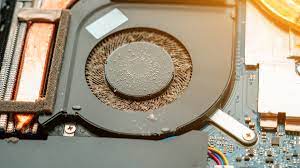Fix a Clogged Fan of a Laptop
The exact broken or need a repair thing in this image is a clogged fan of a laptop. This part appears to be damaged due to dust accumulation, and needs immediate attention to restore full functionality.
Tools needed:
* Screwdrivers (Phillips and flathead)
* Compressed air (canned air)
* Soft brush (e.g., a small paintbrush)
* Thermal paste (optional)
Step-by-Step Detailed Guide to Fix it:
- Shut down your laptop and unplug it: Make sure your laptop is turned off and unplugged from the power source to avoid any accidental startups or electrical shocks.
- Ground yourself: Static electricity can damage your laptop's components. Touch a grounded metal object or wear an anti-static wrist strap to discharge any static electricity from your body.
- Remove the screws: Use a Phillips screwdriver to remove the screws that hold the laptop's bottom panel in place. The location of these screws may vary depending on your laptop model.
- Open the laptop's bottom panel: Gently pry open the bottom panel, taking care not to damage any surrounding components.
- Locate the fan: Identify the clogged fan, which is usually located near the center of the laptop.
- Clean the fan: Use compressed air to blow out any loose dust and debris from the fan. Hold the can upright and spray the air in short bursts to avoid pushing debris further into the fan.
- Use a soft brush: Use a soft-bristled brush to gently sweep away any remaining dust and debris from the fan blades and surrounding area.
- Inspect and clean the heat sink: Use compressed air and a soft brush to clean the heat sink, which is usually located near the fan.
- Reassemble the laptop: Reattach the bottom panel and replace the screws.
- Test the fan: Turn on your laptop and check if the fan is working properly.
Tips and Warnings:
* Regular cleaning: Regularly cleaning your laptop's fan and heat sink can help prevent clogging and overheating issues.
* Avoid using liquids: Never use liquids, such as water or cleaning solutions, to clean your laptop's fan or heat sink, as they can damage the components.
* Be gentle: Be careful when handling the fan and surrounding components to avoid damaging them.
* Consult a professional: If you're not comfortable with this repair or if the issue persists after cleaning, consider consulting a professional for further assistance.
* Monitor temperatures: Keep an eye on your laptop's temperatures to ensure they're within a safe range. You can use software tools, such as SpeedFan or HWMonitor, to monitor temperatures.





